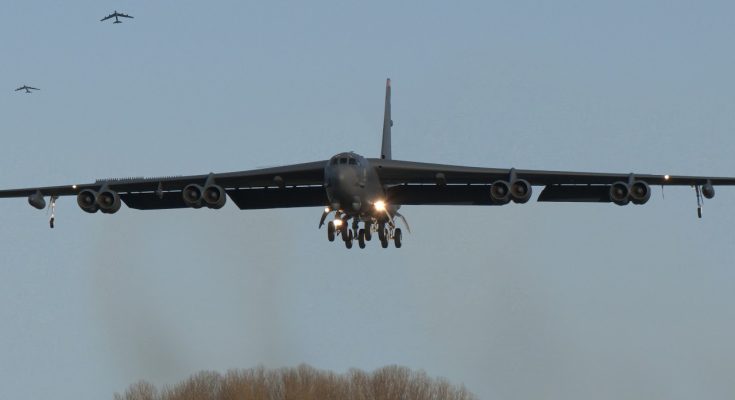B-52 Bomber Planes in Europe: Extreme Take-offs and Landings in Crosswind
The B-52 Stratofortress, a stalwart of American military airpower, is a legendary heavy bomber that has been in service for over six decades. Known for its long-range, high-payload capacity, and strategic capabilities, the B-52 continues to be a key component of U.S. and NATO defense. Operating from bases in Europe, however, presents unique challenges, especially when dealing with extreme take-offs and landings in crosswind conditions.
Crosswinds and Their Challenges
Crosswinds—winds blowing perpendicular to the runway—pose one of the most difficult challenges for pilots, especially for large, high-wing aircraft like the B-52. The massive wingspan of the B-52, measuring over 185 feet, creates a large surface area that can be significantly affected by gusty, crosswind conditions. When winds hit the aircraft at an angle, they can push the plane off course, which requires the pilot to make precise corrections throughout the take-off and landing processes.
In Europe, where weather conditions can be unpredictable and often windy, crosswinds are a frequent occurrence. Locations like RAF Fairford in the UK, and other NATO bases, often experience gusty winds, making B-52 operations especially challenging in those regions. As a result, B-52 crews must be highly skilled in handling extreme crosswind situations to ensure safe take-offs and landings.
Take-off in Crosswinds
During takeoff, the B-52’s large and heavy airframe, which weighs over 500,000 pounds, is prone to drift when subjected to crosswinds. The plane’s high-wing design, while beneficial for its long-range missions, makes it particularly vulnerable to crosswinds during ground operations. As the aircraft accelerates down the runway, pilots need to keep the plane aligned with the centerline, even as wind forces try to push the aircraft off track.
Pilots make corrections by applying rudder inputs to counteract the wind’s effect and keep the aircraft on the runway. This is especially critical during the initial phase of takeoff, when the B-52 has not yet reached the speed necessary to generate full lift and stability. Proper control is essential to prevent the aircraft from veering off course or losing directional stability.
Additionally, the B-52’s long takeoff roll requires pilots to maintain steady control as they reach takeoff speed, while simultaneously monitoring wind direction and intensity. With the aircraft’s wings moving through the air at higher speeds, even the smallest of crosswind corrections can become a challenge, requiring sharp attention and skillful maneuvering.
Landing in Crosswinds
Landing in crosswind conditions is perhaps even more complex. Pilots must make continuous adjustments to keep the aircraft aligned with the runway as they approach. The B-52 is a large aircraft with a relatively high landing speed, which makes crosswind landings even more difficult because of the need to maintain control at lower speeds during the final approach.
To counteract the crosswind, pilots typically use a technique known as the “crab angle.” In this approach, the aircraft is slightly banked into the wind to prevent drifting off course. This requires constant adjustments as the aircraft descends toward the runway. As the B-52 nears the runway threshold, the pilot must straighten the aircraft, aligning it perfectly for touchdown. Any misjudgment at this critical moment can result in a dangerous landing, where the aircraft might skid, veer off the runway, or even experience a loss of control.
Given the B-52’s relatively large wheels and landing gear configuration, it’s more prone to bouncing in crosswind conditions compared to smaller aircraft. Thus, ensuring a smooth touchdown is a delicate balance between maintaining enough speed for control and reducing speed enough to prevent excessive bounce or drift.
Mitigating Risks
B-52 crews undergo extensive training to handle such demanding conditions. Before attempting crosswind take-offs and landings, pilots review weather forecasts carefully and often defer to crosswind limits based on the current wind conditions. In extreme situations, flights may be delayed or redirected to other airfields where the wind conditions are more favorable.
NATO and U.S. Air Force crews also practice simulated landings and take-offs in crosswind conditions during training exercises, often using the aircraft’s unique handling characteristics to refine their skills. Moreover, technological aids like autopilot systems, which can help control some aspects of the approach, may also be employed, although the human element remains crucial for safe operations in extreme conditions.
Conclusion
The B-52 Stratofortress is a remarkable aircraft capable of enduring tough conditions, but operating it in Europe—where crosswinds are frequent—adds a layer of complexity to an already challenging mission. Pilots must rely on precision, skill, and experience to handle extreme take-offs and landings in crosswinds, ensuring the safety of both the crew and the aircraft. Despite these challenges, the B-52’s continued operational success in Europe underscores its adaptability and the unwavering expertise of the aircrews who fly it.



